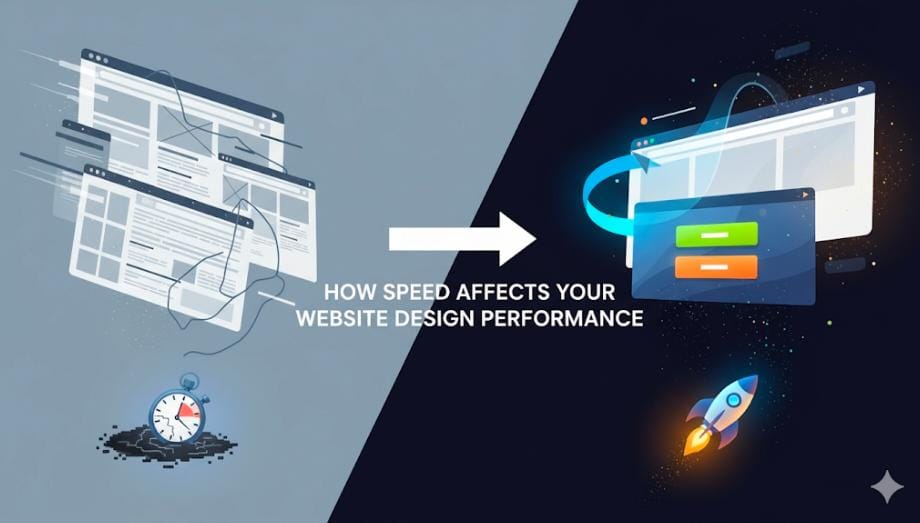Ever visit a site and wait? And wait some more? And then just bounce? You’re not alone. Site speed is no longer a technical nicety. It’s the kiss of death for your online success. Let’s find out why speed is now so important and what you can do about it.
Why Speed Is Everything Now
Think about your own actions as a browser. How long do you remain on a sluggish site? Not very long, likely?
Here is what the numbers tell us: Pages loading in one second have 3.05% conversion rates. Pages taking five seconds? A meager 1.12%. That is a significant drop. Gaining one second boosts conversions by 5.6%. For busy websites, that is tens of millions of extra dollars.
User action verifies it. Bounce rates grow 32% when load time goes from 1 to 3 seconds. At 5 seconds? They increase by 90%. The BBC loses 10% of visitors per extra second. And 53% of mobile surfers abandon sites that take longer than 3 seconds to load.
That’s why investing in Custom Web Design Services is crucial — optimized, lightweight designs not only enhance user experience but directly impact your conversion rates. Can your business survive losing half of your customers?
What’s Slowing Down Your Site?
Your design choices have a direct impact on load speed. Some assist. Some oppress. Let’s take control of the worst culprits and determine what you can do to change them.
Images: Your Biggest Speed Killer
Do you have any idea what takes up most of your page weight? Images. They typically account for 80% of your total page size. That’s huge.
Slow-pocalypse images that aren’t optimized bring everything to a crawl. Mobile users suffer the most. They want fast experiences but get slow loads instead.
What’s the solution? Start with lazy loading. This delays image loading until users scroll down to them. Result? At least 10% faster loading times. Your visual quality doesn’t change.
Then, use newer formats like WebP and AVIF. They are compressed more tightly than older ones. You get smaller files without losing quality. Everyone gains.
Code That Slows Everything Down
How clean is your code? Trashy code makes everything slow. Too much JavaScript and CSS files keep the page from rendering. Your page won’t appear until they are done loading. Dirty code with lots of unnecessary spaces and comments makes your file bigger. Processing is slower.
Minification to the rescue. It strips out stuff you don’t need. Files shrink. Load speed improves. Simple fix, massive effect.
And what of those plugins you’ve added? Each one processes separate requests. Analytics scripts, social media widgets, ads – they all add overhead. More scripts = slower load. Do you really need them all?
Fancy Features That Cost You
Love those silky smooth transitions? Custom fonts? Parallax effects? They’re cool, right?
But the thing is, they drag everything down. These things consume more resources and processing. It is your users who end up paying for it in the form of longer delays.
Is this sounding like giving up all visual elegance? No way. It is about being discerning. Use system fonts whenever you can. Keep animation minimal. Choose features that contribute to experience without affecting performance.
It is a balance. Can you be lovely without slowing down?
Mobile Speed and Design
Responsive design affects the speed at which your site loads on different devices. If done well, it speeds things up. If done poorly? Bottlenecks are created.
Good responsive design makes content delivery easier. Gets rid of the need for mobile versions. Everything is loaded faster. But poor implementation loads additional resources on mobile. That slows it down.
Mobile-first design is best. Why? It puts priority content first. It uses resources sparingly from the beginning. Your mobile users enjoy optimal performance. Desktop users receive rightfully scaled experiences. Everyone’s happy.
Google’s Speed Metrics Matter
Google examines your page with Core Web Vitals. Three of the most significant aspects are examined: Largest Contentful Paint (LCP), Interaction to Next Paint (INP), and Cumulative Layout Shift (CLS). They directly pertain to your design choices. They’re ranking factors as well.
- Want better scores? Improve these design elements:
- Clean layouts minimise complexity. Less code loads quicker.
- Proper space between dynamic content prevents annoying shifts. Your layout is stable.
- Smart typography using web-safe fonts is fast to load. Fancy fonts are slow.
- Optimised images with the correct size and placement boost LCP scores. Your main content loads faster.
Small changes. Great difference.
How to Speed Things Up
Ready to make your site fly? Let’s look at proven strategies that work. These break into technical solutions and design approaches.
Technical Solutions That Work
Ever heard of Content Delivery Networks? CDNs accelerate loading by 50%. How? They distribute your content to multiple servers around the world. Users are delivered from local locations. Latency decreases. Performance is consistent wherever.
Browser caching helps too. It caches static resources locally for repeat visitors. They load pages much faster on return visits. Fewer requests are sent to the server. User experience is considerably improved.
Have you properly set up caching? If not, you’re leaving low-hanging fruit on the table.
Design Speed Strategies
Need faster loading? Reduce your design. Simple designs load faster. They also provide better user experiences. Clean beats clutter every time.
Prioritise above-the-fold content. What users first see should load first. Logical, right? Everything else can wait.
Progressive enhancement comes alive here. Fundamental functionality, first. Fancy features layered on top for robust hardware and fast connections. Everyone gets a usable site. Some get richer ones. No one gets left out.
The Money Side of Speed
Let’s talk about real-world impact. Speed optimization has a direct, bottom-line effect on you.
Walmart saw 2% conversion gains for every one-second gain. A study shows reducing load time from 6 to 2 seconds raises conversions by 1.68% to 1.12%. That doesn’t sound like much. But for big-traffic e-commerce sites? That’s millions of additional revenue annually.
Speed enhances search engine rankings. Better rankings drive more organic traffic. More traffic means more opportunities. The snowball keeps rolling. Can you afford to ignore these profits?
Final Thoughts
Site speed affects all facets of your web life. It shapes design decisions. It determines user experiences. It impacts your top line.
Understanding how design elements affect load performance is step one. Applying optimization strategies is step two. The result? Faster, more interactive websites that deliver across the board.
User satisfaction rises. Conversions are higher. Revenue is higher. Search rankings enhance. All due to accelerating your site.
So where do you start? Pick one thing from this guide. Maybe it’s image optimization. Maybe it’s code cleanup. Or maybe it’s adding CDN. Just start somewhere






